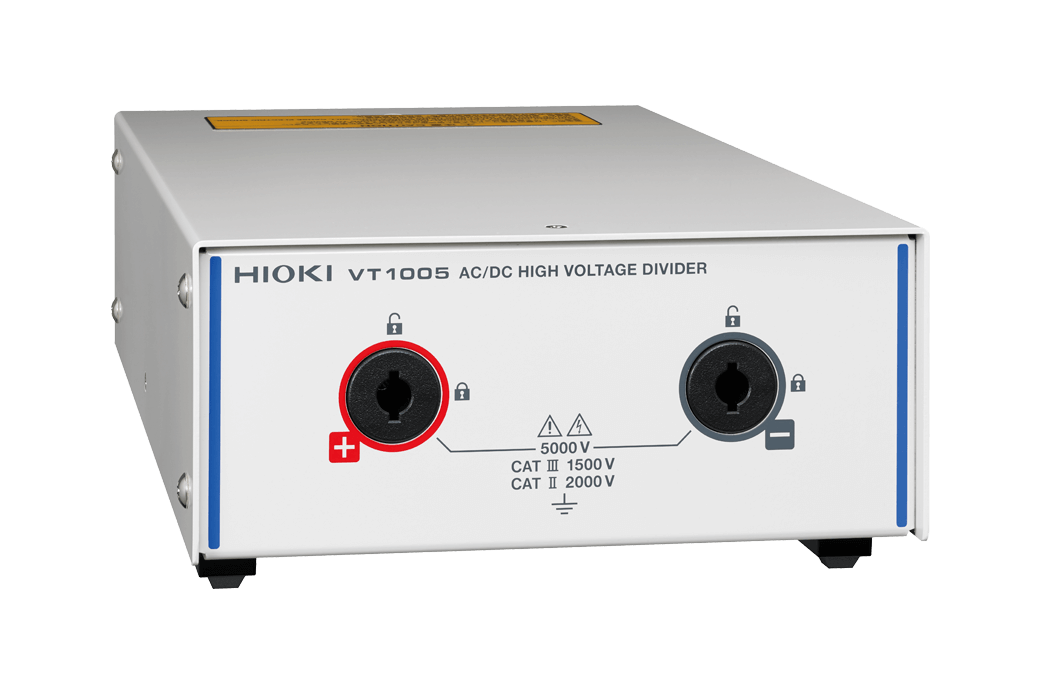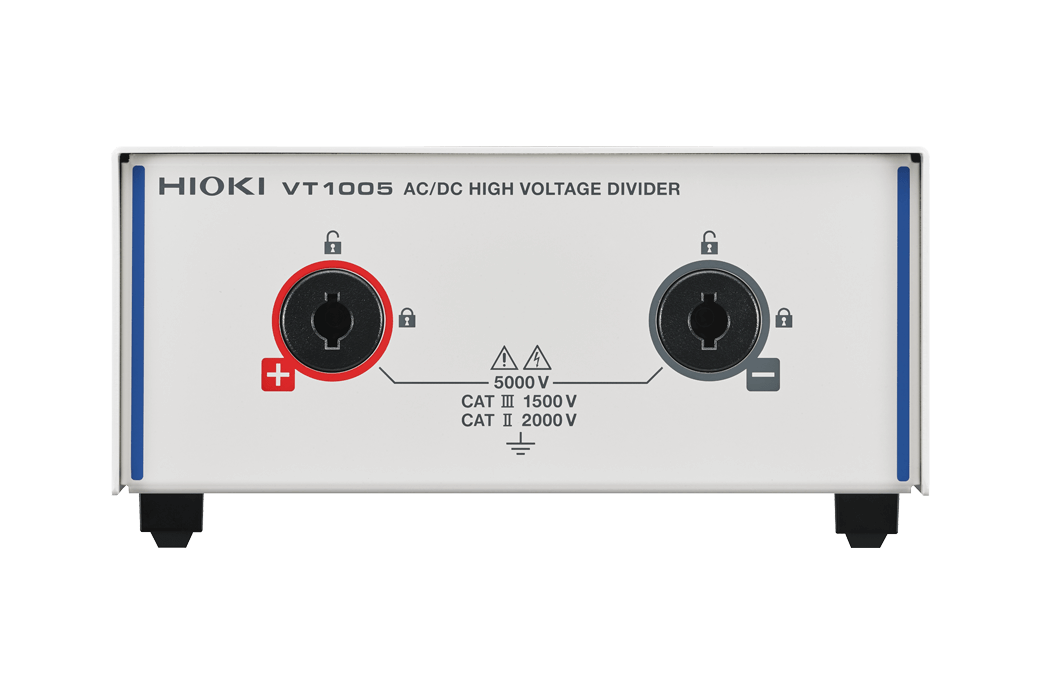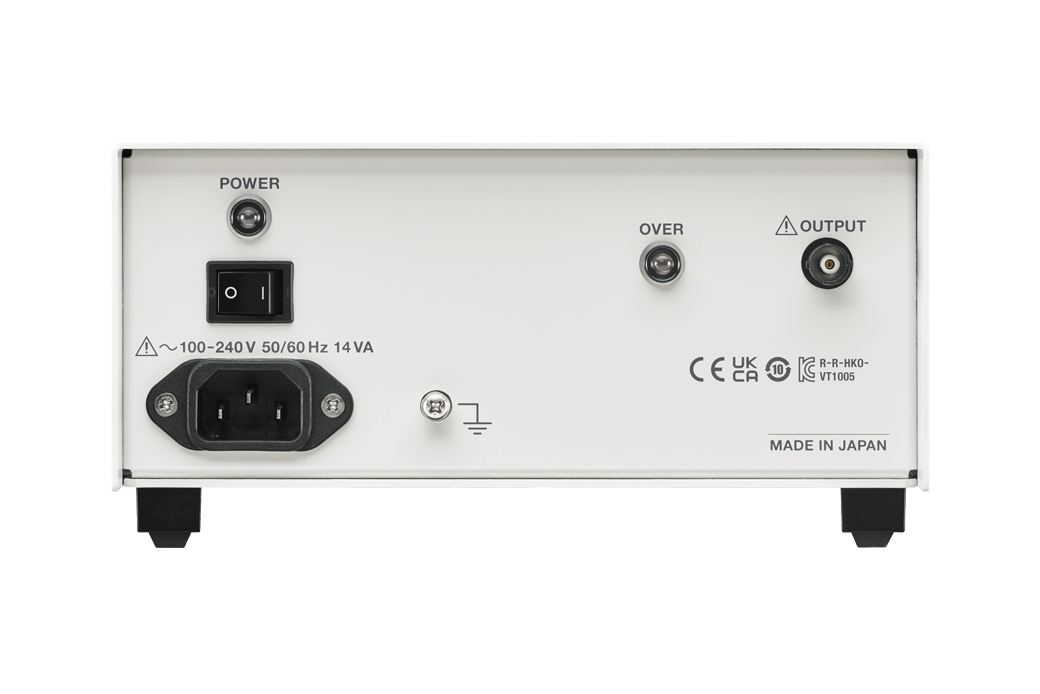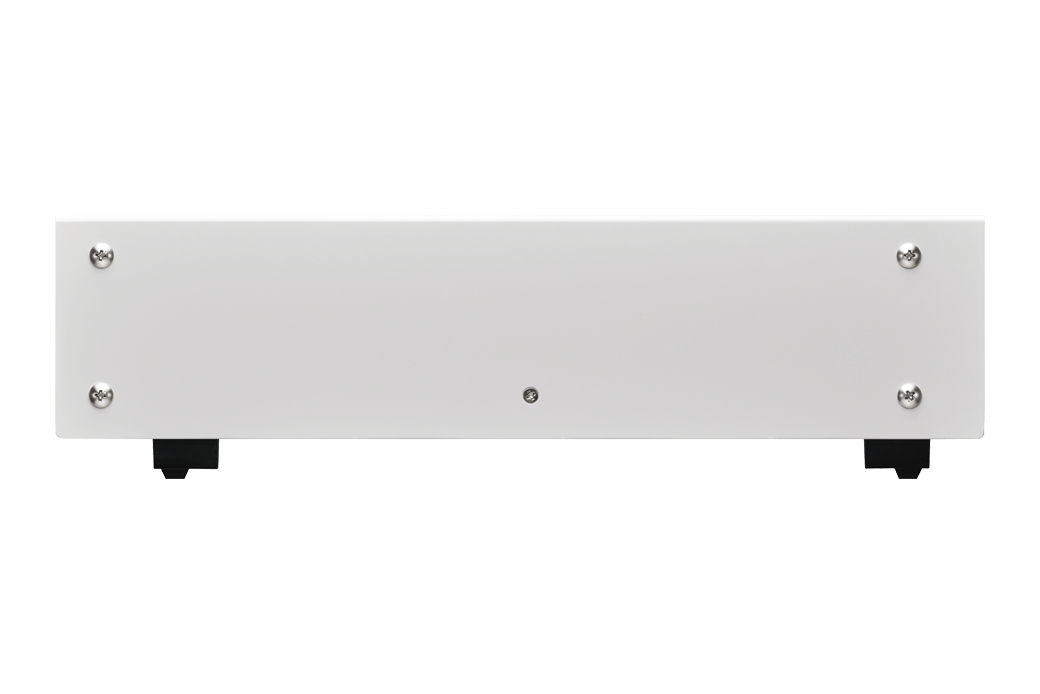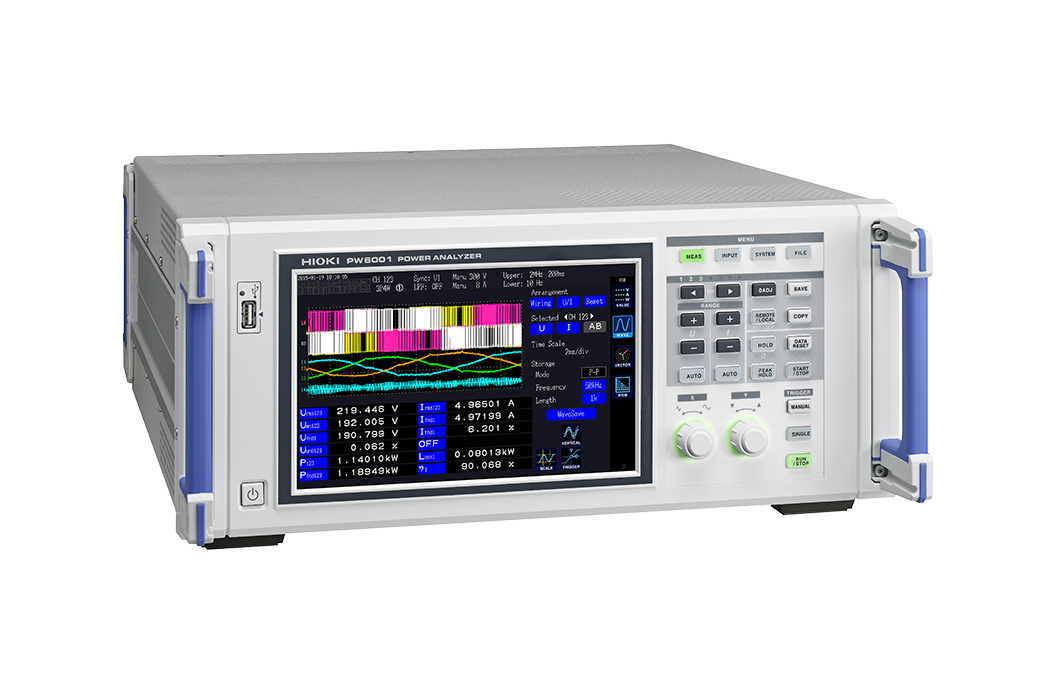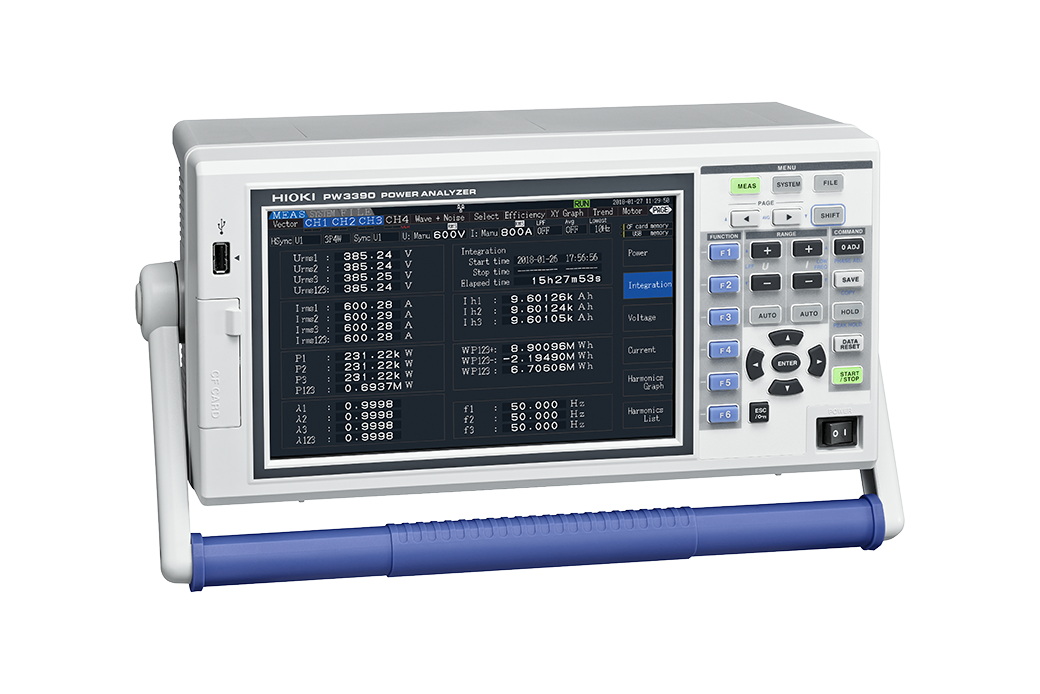AC/DC HIGH VOLTAGE DIVIDER VT1005
Safely Measure High Voltages up to 5000 V
Detect Efficiency Improvement Effects on the Order of 0.1%
Inverters used in rail and power system applications convert high-voltage power. To measure the efficiency of such conversions, it’s necessary to measure voltages of 1000 V and above. The VT1005 divides voltages of up to 5000 V and outputs them to a power analyzer.In order to measure the efficiency of high-efficiency inverters with a high degree of precision, you need to be able to accurately measure power from DC to high frequencies. Thanks to its excellent frequency flatness, the VT1005 makes possible accurate measurement at frequencies ranging from the fundamental wave to switching-frequency components.
Key Features
- Max. Input 5000 V (*1)
2000 V CAT II
1500 V CAT III - Measurement Accuracy:
±0.08% (DC)
±0.04% (50/60 Hz)
±0.17% (50 kHz) - Frequency Flatness:
±0.1% Amplitude Band 200 kHz Typ.
±0.1° Phase Band 500 kHz Typ. (*2) - Measurement Band:
DC to 4 MHz (-3 dB) - Noise Resistance:
CMRR 80 dB Typ. (100 kHz)
Differential Input Method
- *1:±7100 V peak, no measurement category, anticipated transient overvoltage of 0 V
- *2:After phase correction by the power analyzer
Model No. (Order Code)
| VT1005 |
|---|
Divides High Voltage by 1000:1 and Outputs
- Max. Input 5000 V (*1), 2000 V CAT II , 1500 V CAT III
Generally, a power analyzer alone cannot directly measure voltages above 1000 V (AC). With the VT1005, large voltages of up to 5000 V can be accurately measured with a power analyzer.
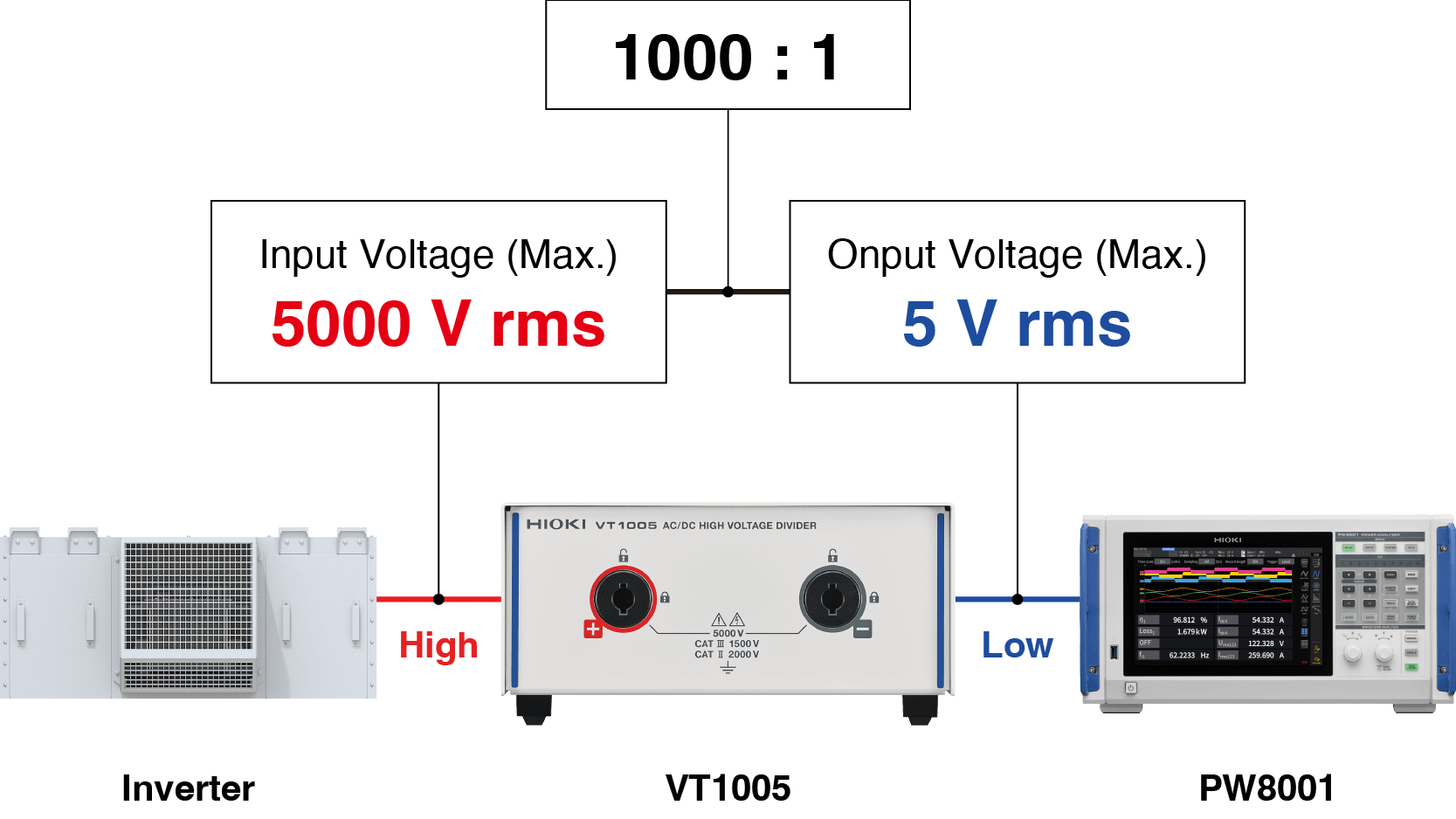
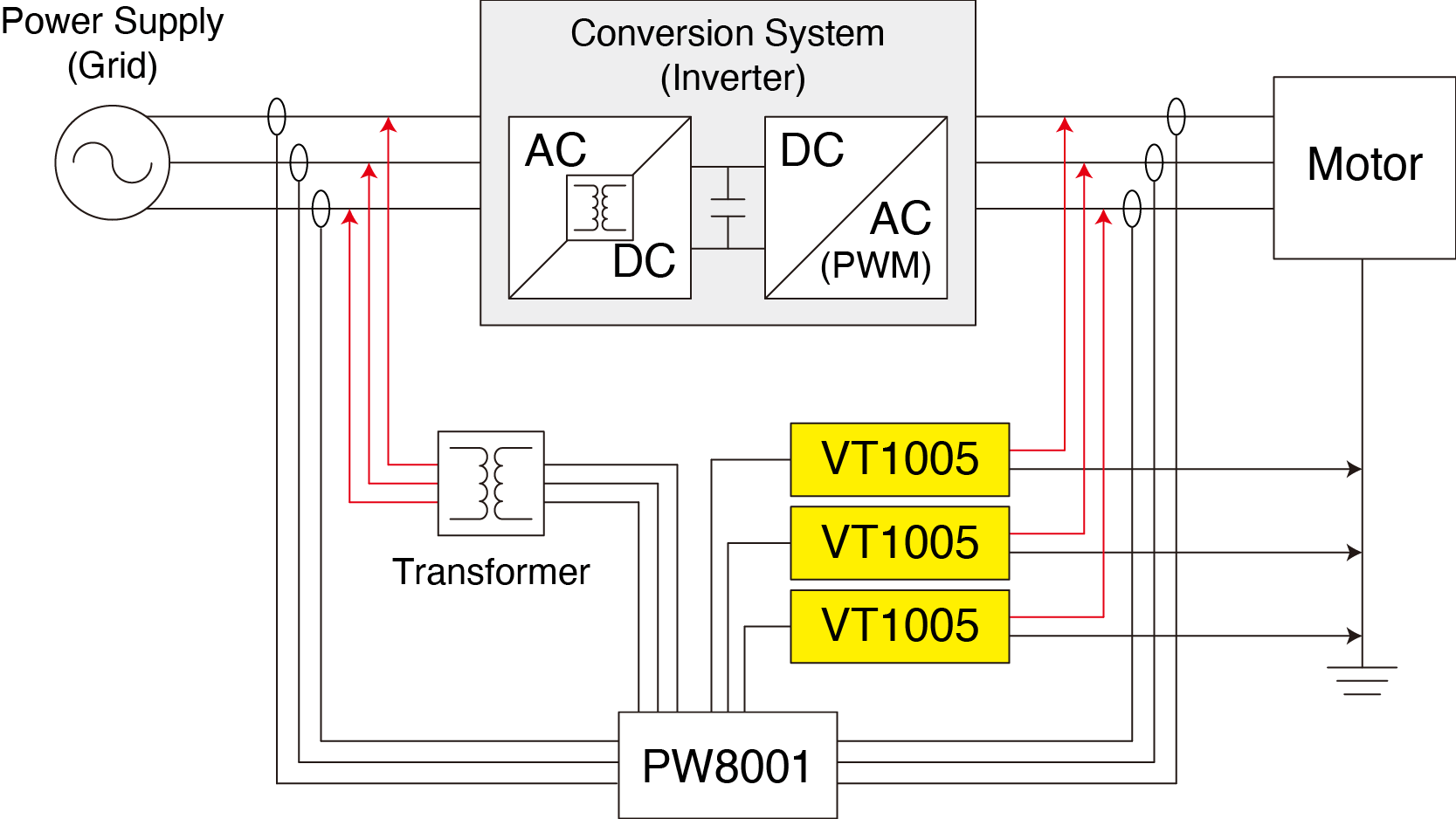 Evaluation of the Efficiency of Inverters That Use SiC Power Devices in Electrical Railways
Evaluation of the Efficiency of Inverters That Use SiC Power Devices in Electrical Railways
Example of VT1005 and PW8001 connection
| PW8001 and VT1005 | PW8001 Standalone (*4) | |
|---|---|---|
| Rated Voltage | AC/DC 5000 V ±7100 V peak | AC 1000 V (*5) ±2000 V peak |
| Measurement Category | AC/DC 5000 V (*1) AC/DC 2000 V CAT ll (*2) AC/DC 1500 V CAT lll (*3) | AC 1000 V CAT ll (*6) AC 600 V CAT lll (*6) |
- *1:±7100 Vpeak, no measurement category, anticipated transient overvoltage of 0 V
- *2:Anticipated transient overvoltage of 12000 V
- *3:Anticipated transient overvoltage of 10000 V
- *4:When using the U7001 input unit
- *5:DC 1500 V
- *6:DC 1500 V CAT II, DC 1000 V CAT III, Anticipated transient overvoltage of 8000 V
Accurate Power Measurement From Fundamental to Switching Frequency Components
- Measurement Accuracy: ±0.08% (DC), ±0.04% (50/60 Hz), ±0.17% (50 kHz)
- Frequency Flatness: ±0.1% Amplitude Band 200 kHz Typical
- Frequency Flatness: ±0.1° Phase Band 500 kHz Typical (*1)
- Measurement Band: DC to 4 MHz (-3 dB)
- *1:After phase correction by the power analyzer
The VT1005 can measure voltage with excellent accuracy across a broad band of frequencies. Accuracy is 0.1% or less at DC and commercial frequencies (50/60 Hz). In addition, the device can measure the most commonly used switching frequencies (10 kHz or less) and the switching frequencies of inverters that use SiC power devices (from 10 kHz to 50 kHz) with a high degree of accuracy.
Key Considerations for Accurately Measuring Efficiency
Active power on the output side of inverters includes not only the fundamental component, but also switching components. In order to measure efficiency with a high degree of precision, you must be able to accurately measure not only the fundamental component, but also switching components.
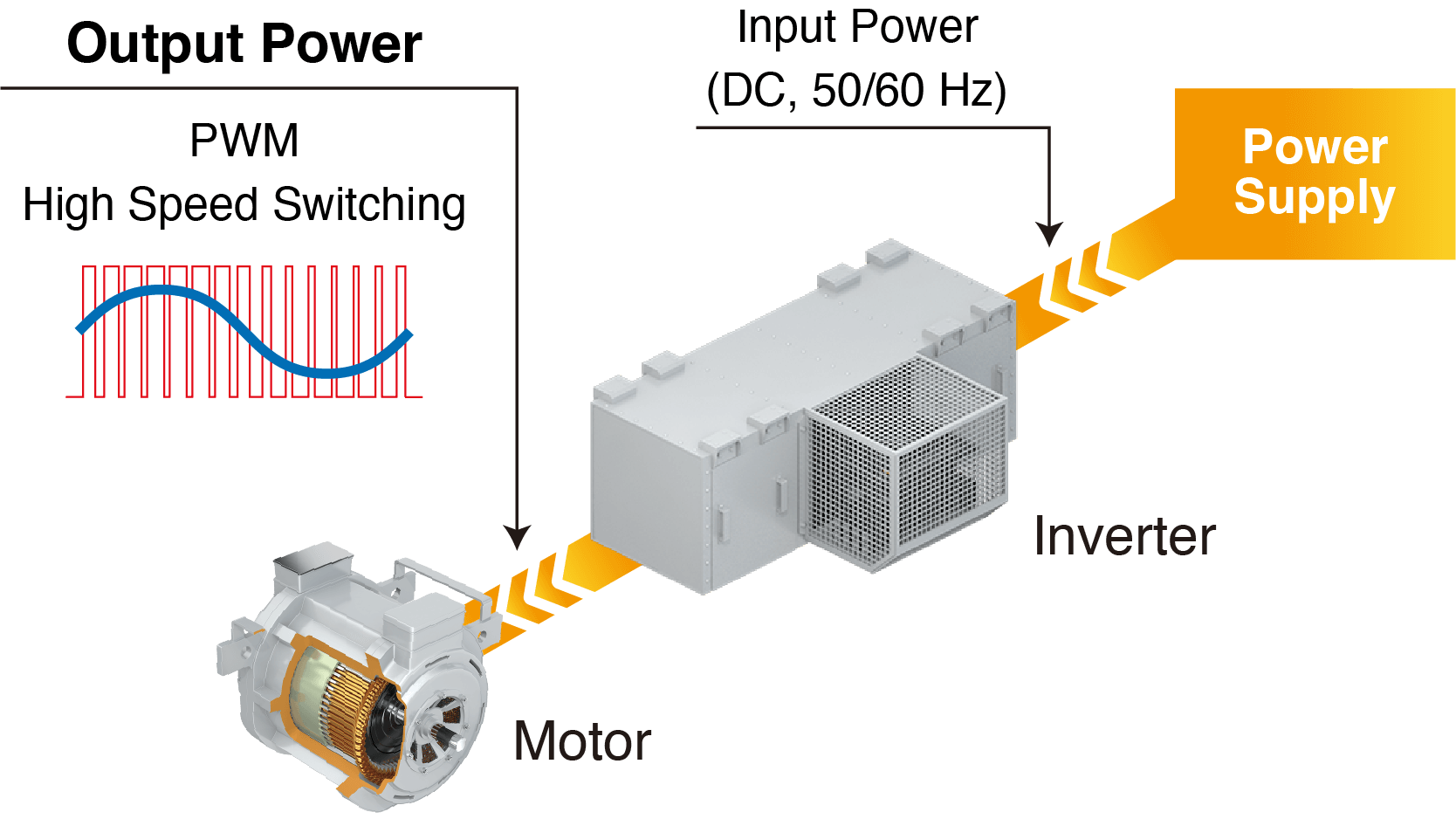
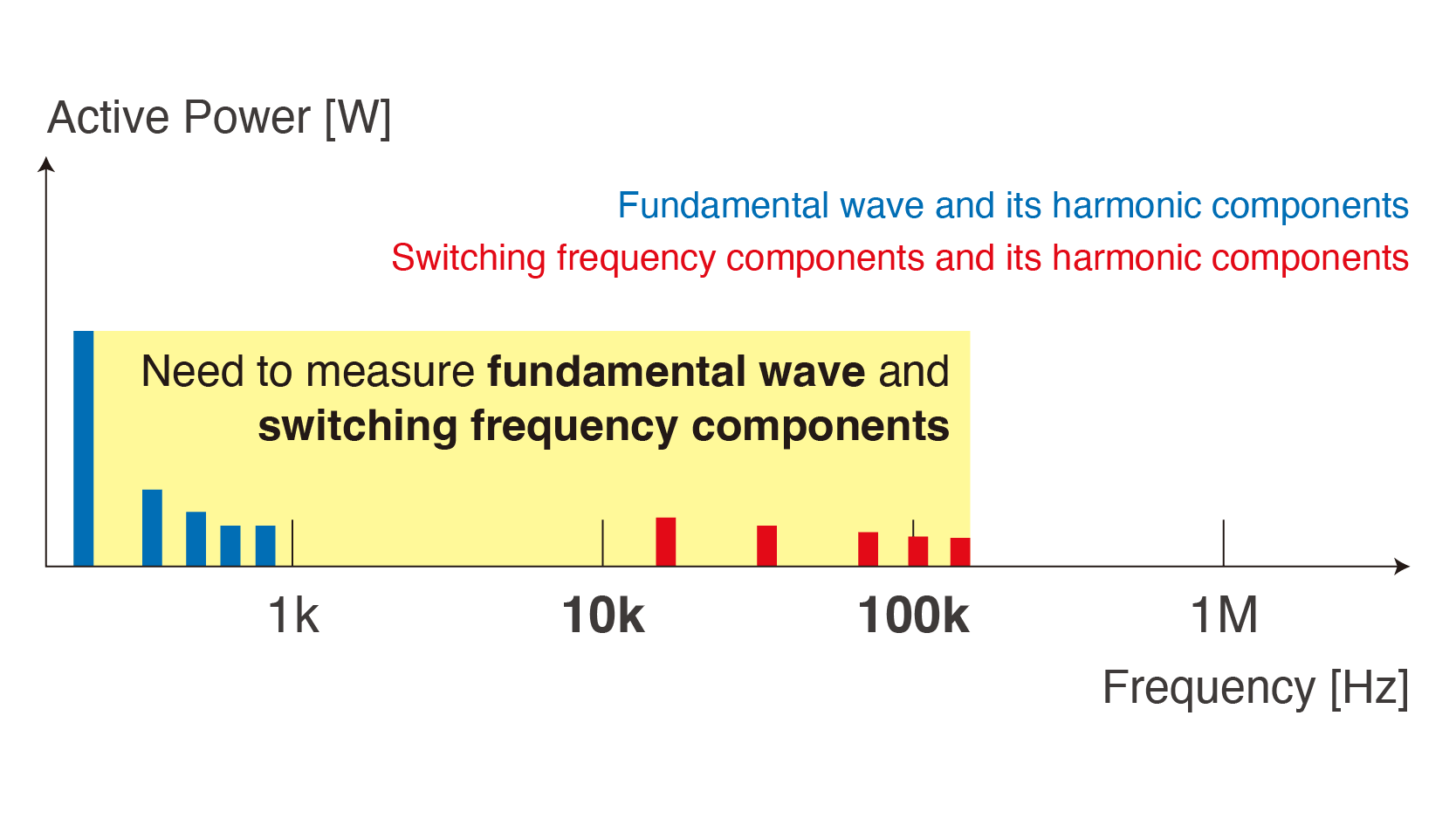 Active Power Spectrogram for an Inverter’s Output Power
Active Power Spectrogram for an Inverter’s Output Power
Differences Between High-Voltage Differential Probes and VT1005
High-voltage differential probes have a broad frequency band, but measurement error on the order of several percent occurs within that band. Thanks to high accuracy and excellent frequency flatness within its frequency band, the VT1005 makes it possible to detect efficiency improvement effects on the order of 0.1%, a task that has been impossible until now.
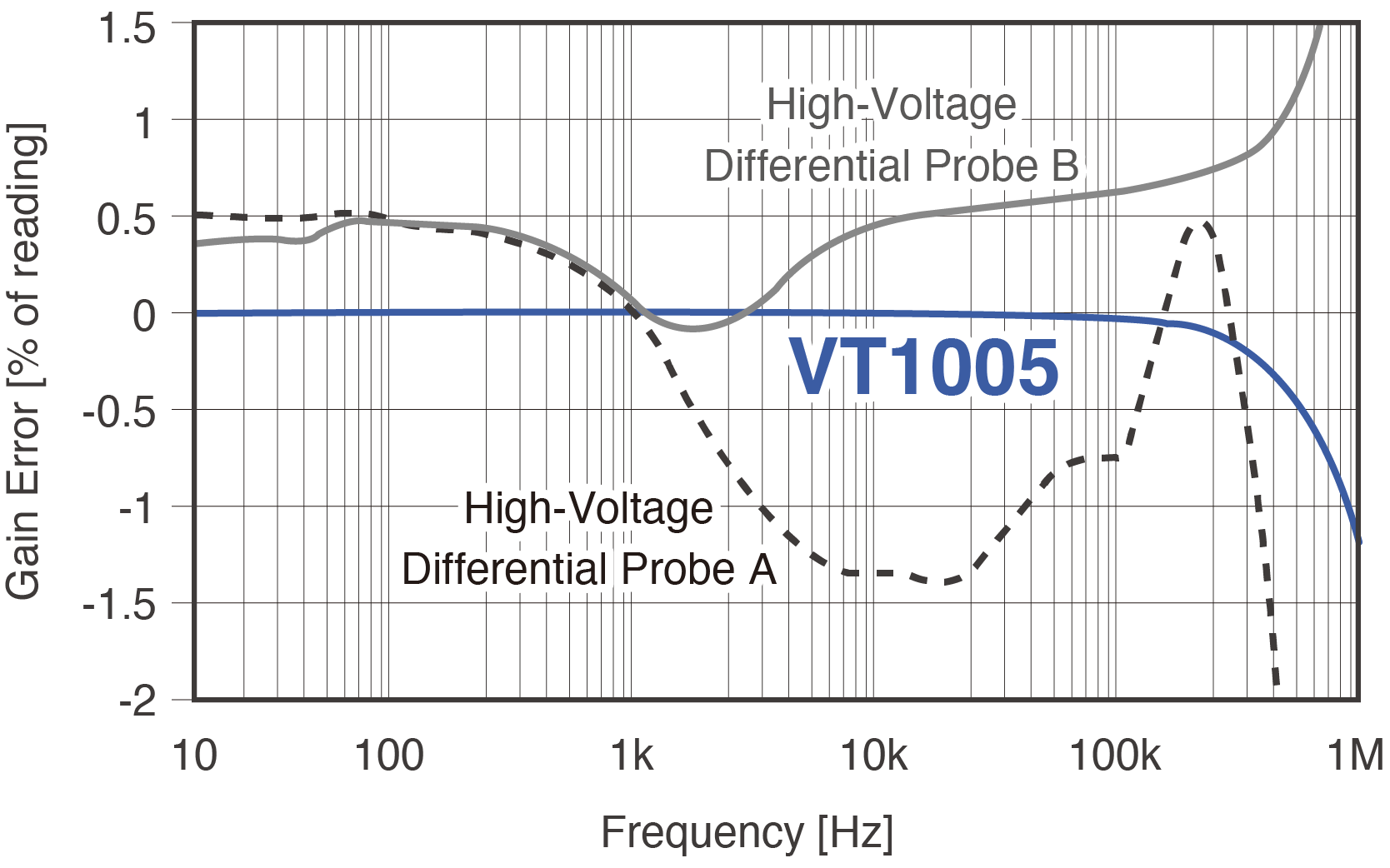
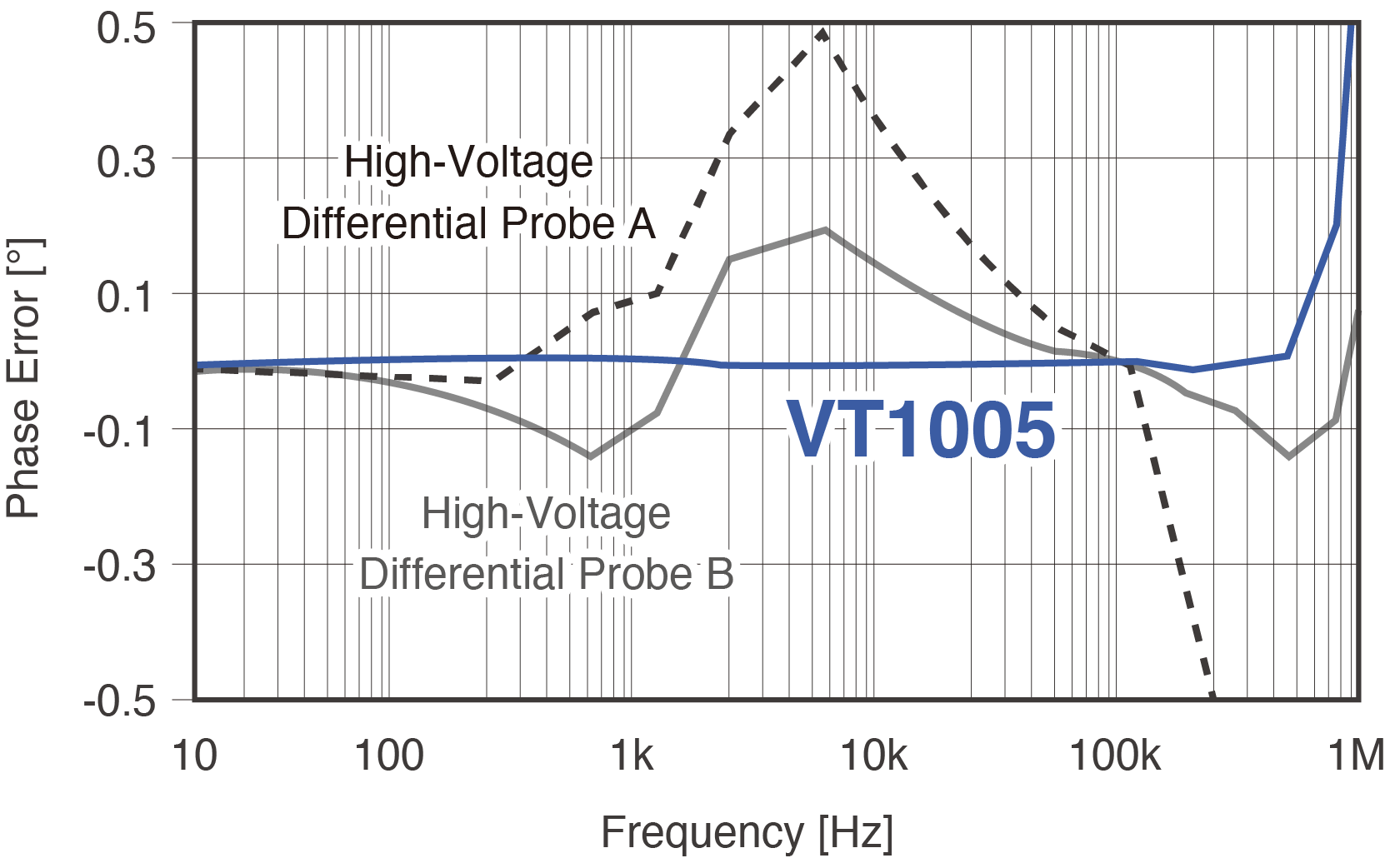 Comparison of High-Voltage Differential Probe and VT1005
Comparison of High-Voltage Differential Probe and VT1005
Accurate and Reproducible Measurement of Inverter Efficiency With Excellent Noise Immunity
- Noise Resistance: CMRR 80 dB Typical (100 kHz), Differential Input Method
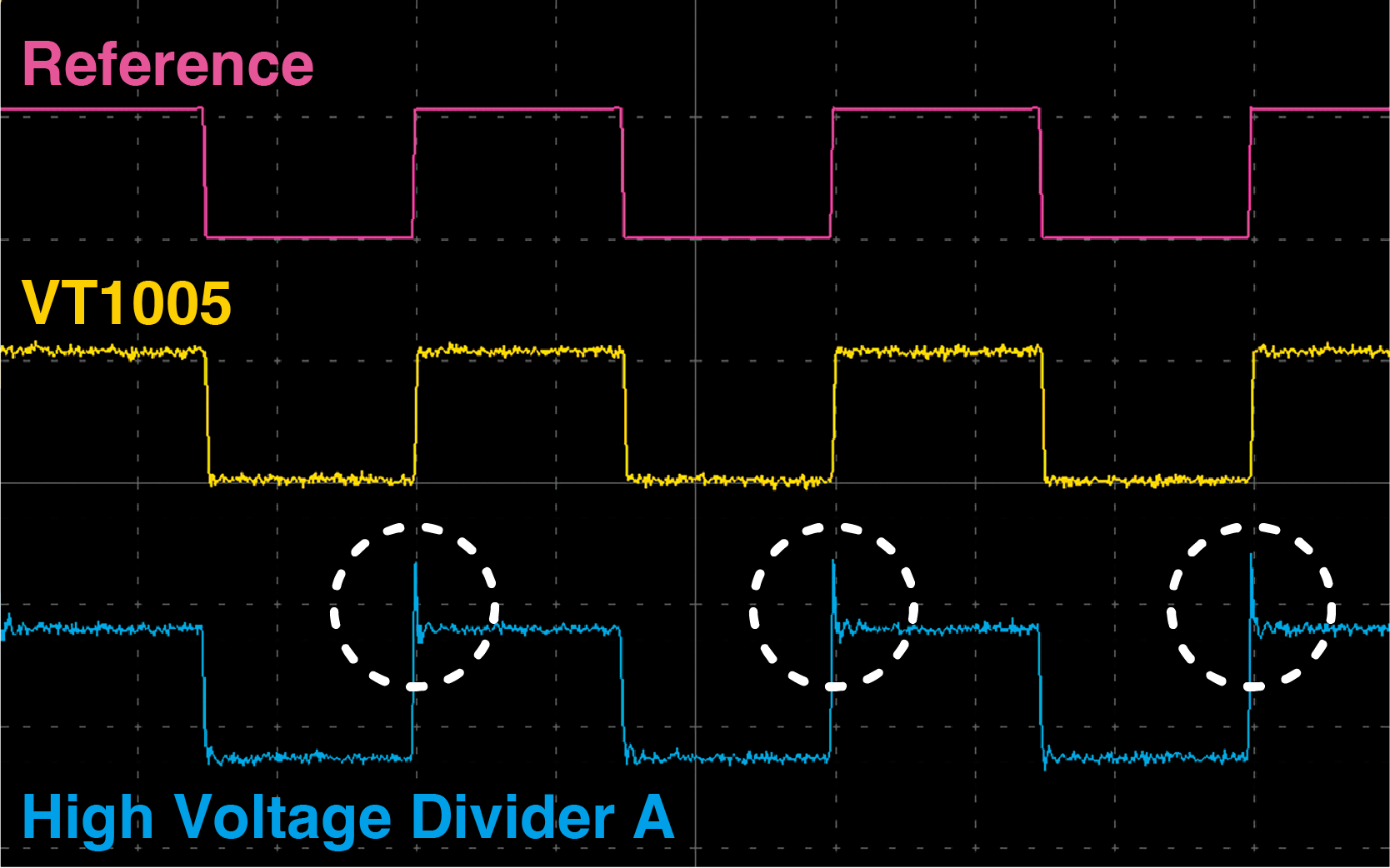
Comparing the noise resistance measurement result of an inverter's secondary side.
The VT1005 is highly resistant to both common-mode and high-frequency noise, allowing it to measure voltage accurately even in noisy environments. Since conversion devices like inverters are sources of noise, noise resistance is important in efficiency evaluation.
Basic specifications
| Maximum rated voltage | 5000 V rms, ±7100 V peak (*1) |
|---|---|
| Maximum rated voltage (line-to-ground) |
No measurement category: 5000 V AC/DC (*2) Measurement category II: 2000 V AC/DC (*3) Measurement category III: 1500 V AC/DC (*4) |
| Voltage dividing ratio | 1000:1 |
| Measurement accuracy | ±0.08%(DC), ±0.04%(50/60 Hz), ±0.17% (50 kHz) |
| Frequency flatness |
Band where amplitude falls within ±0.1% range: 200 kHz (typical) Band where phase falls within ±0.1° range: 500 kHz (typical) (*5) |
| Measurement bandwidth | DC to 4 MHz (Amplitude and phase accuracy specified up to 1 MHz) |
| Common-mode voltage rejection ratio (CMRR) |
50 Hz/60 Hz: 90 dB(Typical) 100 kHz: 80 dB (Typical) |
| Measurement method | Differential input |
| Operating temperature and humidity range | -10°C to 50°C (14°F to 122°F), 80% RH or less (non-condensing) |
| Storage temperature and humidity range | −20°C to 60°C (-4°F to 140°F), 80% RH or less (non-condensing) |
| Standards | Safety: EN 61010 EMC: EN 61326 Class A |
| Power supply | 100 V to 240 V AC (50/60 Hz) |
| Dimensions and Weight | Approx. 195.0 mm (7.68 in) W × 83.2 mm (3.28 in) H × 346.0 mm (13.62 in) D mm Approx. 2.2 kg (77.6 oz.) |
| Included accessories | - L1050-01 Voltage Cord ×1 (1.6 m/ 5.25 ft) - L9217 Connection Cord ×1 (insulated BNC, 1.6 m/ 5.25 ft) - 9704 Conversion Adapter ×1 (insulated-female BNC-to-banana plug) - Power cord ×1 |
- *1:Within the frequency derating range
No measurement category: Applicable to the measurement of circuits that are not directly connected to the main power supply.
EXAMPLE: Measurement on the secondary-side equipment from the socket outlet of fixed installation through a transformer, etc. - *2:±7100 V peak, Anticipated transient overvoltage 0 V
- *3:Anticipated transient overvoltage 12000 V
- *4:Anticipated transient overvoltage 10000 V
- *5:After phase correction by the power analyzer
Measurement accuracy
| Frequency | Amplitude ±(% of reading + % of full scale) |
Phase |
|---|---|---|
| DC | 0.03% + 0.05% | – |
| DC < f < 30 Hz | 0.2% + 0.1% | ±0.1° |
| 30 Hz ≤ f < 45 Hz | 0.1% + 0.1% | ±0.1° |
| 45 Hz ≤ f ≤ 66 Hz | 0.02% + 0.02% | ±0.06° |
| 66 Hz < f ≤ 100 Hz | 0.1% + 0.02% | ±0.12° |
| 100 Hz < f ≤ 1 kHz | 0.1% + 0.02% | ±0.2° |
| 1 kHz < f ≤ 5 kHz | 0.15% + 0.02% | ±0.4° |
| 5 kHz < f ≤ 50 kHz | 0.15% + 0.02% | ±(0.08 × f kHZ)° |
| 50 kHz < f ≤ 100 kHz | 0.5% + 0.02% | ±(0.08 × f kHZ)° |
| 100 kHz < f ≤ 300 kHz | 1.5% + 0.5% | ±(0.08 × f kHZ)° |
| 300 kHz < f ≤ 1 MHz | 5.0% + 0.5% | ±(0.08 × f kHZ)° |
| Frequency band | 4 MHz(-3 dB Typical) | – |
Voltage Cord (2)
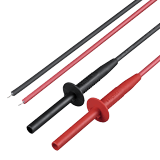
1.6 m

3.0 m
Connection Cord (3)
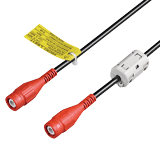
Cord has insulated BNC connectors at both ends, 1.6 m (5.25 ft) length

Cord has insulated BNC connectors at both ends, 3.0 m (9.84 ft) length

Cord has insulated BNC connectors at both ends, 10 m (32.81 ft) length
Conversion Adapter (1)
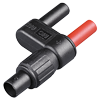
Receiving side BNC (female), output banana (male) *Not compatible with older generation Memory Hicorders with banana input terminals
- Evaluation of the Efficiency of Wireless Power Transfer (WPT) Systems
- Evaluation of the Efficiency of Inverters That Use SiC Power Devices in Industrial Equipment
- Evaluation of Loss in Transformers and Reactors Designed for Use in High-Voltage Circuits
- Evaluation of the Efficiency of Inverters That Use SiC Power Devices in Electrical Railways
- Evaluation of the Efficiency of Solar Inverters That Support High-Voltage Input

